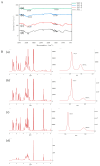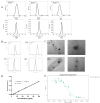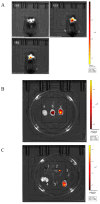A Novel Brain-Targeting Nanoparticle Loaded with Biatractylolide and Its Protective Effect on Alzheimer's Disease
- PMID: 40573206
- PMCID: PMC12196305
- DOI: 10.3390/ph18060809
A Novel Brain-Targeting Nanoparticle Loaded with Biatractylolide and Its Protective Effect on Alzheimer's Disease
Abstract
Background: To enhance the bioavailability and neuroprotective efficacy of biatractylolide against Alzheimer's disease by developing a novel Tween-80-modified pullulan-chenodeoxycholic acid nanoparticle as a delivery vehicle. Methods: Chenodeoxycholic acid (CDCA) was chemically conjugated to pullulan to yield hydrophobically modified pullulan (PUC), onto which polysorbate 80 (Tween-80) was subsequently adsorbed. The PUC polymers with CDCA substitution levels were analyzed by 1H NMR spectroscopy. Nanoparticles were fabricated via the dialysis method and characterized by transmission electron microscopy and dynamic light scattering for morphology, size, and surface charge. In vitro neuroprotection was assessed by exposing SH-SY5Y and PC12 cells to 20 µM Aβ25-35 to induce cytotoxicity, followed by pretreatment with biatractylolide-loaded PUC (BD-PUC) nanoparticle solutions at various biatractylolide concentrations. The in vivo brain-targeting capability of both empty PUC and BD-PUC particles was evaluated using a live imaging system. Results: The 1H NMR analysis confirmed three distinct CDCA substitution degrees (8.97%, 10.66%, 13.92%). Transmission electron microscopy revealed uniformly dispersed, spherical nanoparticles. Dynamic light scattering measurements showed a hydrodynamic diameter of ~200 nm and a negative zeta potential. Exposure to 20 µM Aβ25-35 significantly reduced SH-SY5Y and PC12 cell viability; pretreatment with BD-PUC nanoparticles markedly enhanced cell survival rates and preserved cellular morphology compared to cells treated with free biatractylolide. Notably, the cytoprotective effect of BD-PUC exceeded that of the free drug. In vivo imaging demonstrated that both empty PUC and Tween-80-adsorbed BD-PUC nanoparticles effectively accumulated in the brain. Conclusions: The protective effect of BD-PUC on SH-SY5Y and PC12 cells induced by Aβ25-35 was higher than free biatractylolide solution, and the BD-PUC nanosolution modified with Tween-80 showed a brain-targeting effect.
Keywords: Alzheimer’s disease; biatractylolide; brain targeting; nanoparticle; pullulan polysaccharide.
Conflict of interest statement
The authors declare no conflicts of interest.
Figures






Similar articles
-
Selegiline for Alzheimer's disease.Cochrane Database Syst Rev. 2003;(1):CD000442. doi: 10.1002/14651858.CD000442. Cochrane Database Syst Rev. 2003. PMID: 12535396
-
Physostigmine for Alzheimer's disease.Cochrane Database Syst Rev. 2001;2001(2):CD001499. doi: 10.1002/14651858.CD001499. Cochrane Database Syst Rev. 2001. PMID: 11405996 Free PMC article.
-
Adefovir dipivoxil and pegylated interferon alfa-2a for the treatment of chronic hepatitis B: a systematic review and economic evaluation.Health Technol Assess. 2006 Aug;10(28):iii-iv, xi-xiv, 1-183. doi: 10.3310/hta10280. Health Technol Assess. 2006. PMID: 16904047
-
Systemic pharmacological treatments for chronic plaque psoriasis: a network meta-analysis.Cochrane Database Syst Rev. 2017 Dec 22;12(12):CD011535. doi: 10.1002/14651858.CD011535.pub2. Cochrane Database Syst Rev. 2017. Update in: Cochrane Database Syst Rev. 2020 Jan 9;1:CD011535. doi: 10.1002/14651858.CD011535.pub3. PMID: 29271481 Free PMC article. Updated.
-
Galantamine for Alzheimer's disease.Cochrane Database Syst Rev. 2002;(3):CD001747. doi: 10.1002/14651858.CD001747. Cochrane Database Syst Rev. 2002. Update in: Cochrane Database Syst Rev. 2004 Oct 18;(4):CD001747. doi: 10.1002/14651858.CD001747.pub2. PMID: 12137632 Updated.
References
-
- Sabogal-Guáqueta A.M., Muñoz-Manco J.I., Ramírez-Pineda J.R., Lamprea-Rodriguez M., Osorio E., Cardona-Gómez G.P. The flavonoid quercetin ameliorates Alzheimer’s disease pathology and protects cognitive and emotional function in aged triple transgenic Alzheimer’s disease model mice. Neuropharmacology. 2015;93:134–145. doi: 10.1016/j.neuropharm.2015.01.027. - DOI - PMC - PubMed
Grants and funding
LinkOut - more resources
Full Text Sources

